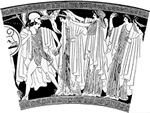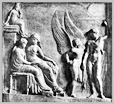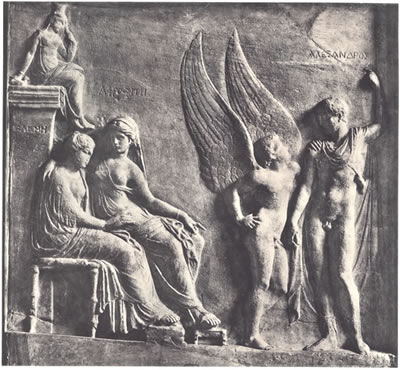
Persuasion in Ancient Greece
Andrew Scholtz, Instructor
Informational Pages. . .
Images of the Abduction / Seduction of Helen
 The following two images depict the abduction and/or seduction of Helen "of Troy." Of course, Helen's original home was not Troy, but Sparta, in southern Greece. There she lived with her husband, Menelaus; it was from there that Paris, a Trojan prince, brought her back to his city to take up with him. Helen had been promised to Paris as reward for his having crowned Aphrodite (goddess of sex) the most beautiful in the contest known as "The Judgment of Paris."
The following two images depict the abduction and/or seduction of Helen "of Troy." Of course, Helen's original home was not Troy, but Sparta, in southern Greece. There she lived with her husband, Menelaus; it was from there that Paris, a Trojan prince, brought her back to his city to take up with him. Helen had been promised to Paris as reward for his having crowned Aphrodite (goddess of sex) the most beautiful in the contest known as "The Judgment of Paris."
 Not unlike Gorgias' Encomium of Helen, this pair of images, though from different periods and places (classical Athens, Roman Italy), problematize the role of persuasion/Peitho in bringing Helen to Troy. Was it by force that she was brought? Did she go of her own free will? If seduced, does persuasion here count as a kind of non-violent coercion?
Not unlike Gorgias' Encomium of Helen, this pair of images, though from different periods and places (classical Athens, Roman Italy), problematize the role of persuasion/Peitho in bringing Helen to Troy. Was it by force that she was brought? Did she go of her own free will? If seduced, does persuasion here count as a kind of non-violent coercion?
And what goes into persuasiveness itself? Can arguments — and not just those relating to seduction or courtship, but political, religious, philosophical, and scientific arguments as well — perform the work they set out to do without "help" from what we might term rhetoric? Could Gorgias be right, even about science, when he suggests that it's really all about shaping impressions and litttle else?
Think about it. We'll be returning to these topics again and again, so you'll have plenty of chance to voice your opinion!
Helen Brought to Troy, "Makron Vase"

Makron Vase. Boston 13.186. Potter: Hieron. Painter: Makron. Attic (= Athenian) red-figure, ca. 490-480 BCE. Side A: showing, from left to right, Aeneas, Alexandros (i.e., Paris), Eros, Helen, Aphrodite, and Persuasion. Side B (not shown) depicts Helen's reunion with Menelaus at Troy: he attacks, she flees. The pictorial elements of both sides are drawn from the so-called epic cycle, specifically, a lost poem known as the Cypria.
Image from Kahil, Lilly. Les Enlèvements Et Le Retour D’hélène Dans Les Textes Et Les Documents Figurés. École Française D’athènes. Travaux Et Mémoires, Fasc. 10. Paris: E. de Boccard, 1955. Vol. 2 Plate IV. See vol. 1 p. 53.
QUESTION: Is Helen being dragged off, "enticed" off, or somehow just led off? Think about all the pictorial elements, including (but not confined to) the meaning of Eros, Aphrodite, and Peitho as symbolic presences. . . .
Click here for more from Perseus.
Seduction of Helen - Naples Relief
Helen Relief. Naples Museo Archeologico inv. 6682. Neo-Attic relief sculpture, first-cent. CE. (Roman date, though showing influences of earlier, Athenian sculpture.) Figures labeled in Greek. Pictured are, from left to right, Peitho ("Persuasion," spelled here "Pitho," sitting atop a pillar), Helen, Aphrodite, Eros ("Desire," = Greek Cupid), and Alexandros, better known as Paris.
Image from Kahil, Lilly. Les Enlèvements Et Le Retour D’hélène Dans Les Textes Et Les Documents Figurés. École Française D’athènes. Travaux Et Mémoires, Fasc. 10. Paris: E. de Boccard, 1955. Vol. 2 Plate XXIV, 1. See vol. 1 p. 225.
(The odd angling of everything, slanting floor etc., seems to result from the camera angle.)
Here we see Aphrodite in her familiar role as "Paregoros," "Consoler." Other evidence emphasizes her role in consoling young brides distressed by the wrenching change marriage would bring them: new home, new family, etc., etc. Here, Aphrodite evidently seeks to reconcile Helen to a change of husband, among other things.
But what is Eros doing, and what (if any) is Paris' role? Eros seems to be staring attractiveness into into Paris' eyes; we shall talk about the role of the eyes in matters of desire. Note how Helen is clothed, while the nude and beardless Paris (probably holding a lance in his left hand) seems meant to convey the idea of youthful male attractiveness. QUESTION: What, exactly, is Paris doing? And what about Peitho — how should we interpret her pose, positioning, etc.?. . .
